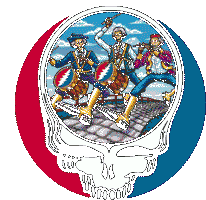Grateful Dead legacy thrives

From Mercury News:
Grateful Dead legacy thrives
DESPITE GARCIA'S DEATH, BAND REMAINS ALIVE FOR FANS
By Seth Schiesel
New York Times
One of the icons of modern U.S. culture now resides in a nondescript warehouse about 30 miles north of San Francisco, in a windowless, climate-controlled, heavily alarmed room built like a bomb shelter that is called simply the Vault.
There, in towering rows of 13,000 audiotapes, 3,000 videotapes and about 250,000 feet of traditional 16-millimeter film lives the recorded history of the Grateful Dead, a seminal U.S. rock band.
The Grateful Dead ceased to exist Aug. 9, 1995, when the band's lead guitarist and most recognizable figure, Jerry Garcia, died at age 53 of a heart attack at a drug treatment center. Yet 10 years later, the man and the band remain alive for millions of fans, and the once notoriously ad hoc Grateful Dead business operation has become a model for a music industry struggling with the Internet and digital democracy.
Loyal fan base
``When I first got into the record business I learned that it wasn't cool to be into the Grateful Dead,'' said Christopher Sabec, 40, an attorney who said he saw the band more than 250 times and is now chief executive of the Jerry Garcia estate, controlled by Garcia's heirs. ``But if you look at where the music business has been forced to go by technology, now it's not about selling records. It's about live shows and inspiring a fan base to be absolutely loyal.''
The Jerry Garcia company and Grateful Dead Productions are separate businesses each generating millions of dollars of revenue a year. Just how many millions is not publicly known. But consumers still buy more than 1 million J. Garcia-brand neckties each year, and Cherry Garcia is often the top-selling brand of Ben & Jerry's ice cream, each pint generating royalties for the Garcia heirs.
The band's four surviving members -- the drummers Mickey Hart and Bill Kreutzmann, the bassist Phil Lesh and the guitarist Bob Weir -- have toured occasionally as the Dead, though not this year. They control the Grateful Dead's licensing business, which oversees thousands of products sold around the world, like gas tank caps, incense burners, golf club covers and sandals. (The Garcia company receives a share of the proceeds.)
But for cultural and practical matters, the heart of the Grateful Dead's legacy resides in the 10,000 cubic feet of space in Novato. The Vault feeds a continuing business based on regular releases of old concert recordings on iTunes, on the band's Web sites and in stores. Physically, there is only one key to the Vault, and only two people know where to find it. David Lemieux, 34, the band's archivist, is one of them. Jeffrey Norman, one of the band's engineers, is the other.
J. Garcia brand
In addition to ties and ice cream, the Garcia company has expanded into rugs and wine. An artist as well as a musician, Garcia signed his work ``J. Garcia.''
``I'm not trying to turn the J. Garcia brand into something you find at Target, but I am trying to broaden it,'' Sabec said. ``There are J. Garcia carpets that my mother would be happy to have in her house, and she's not a Deadhead. If you were to position it only for people who were fans of Jerry's music, it would be a much smaller market than what we're going for.''



0 Comments:
Post a Comment
<< Home